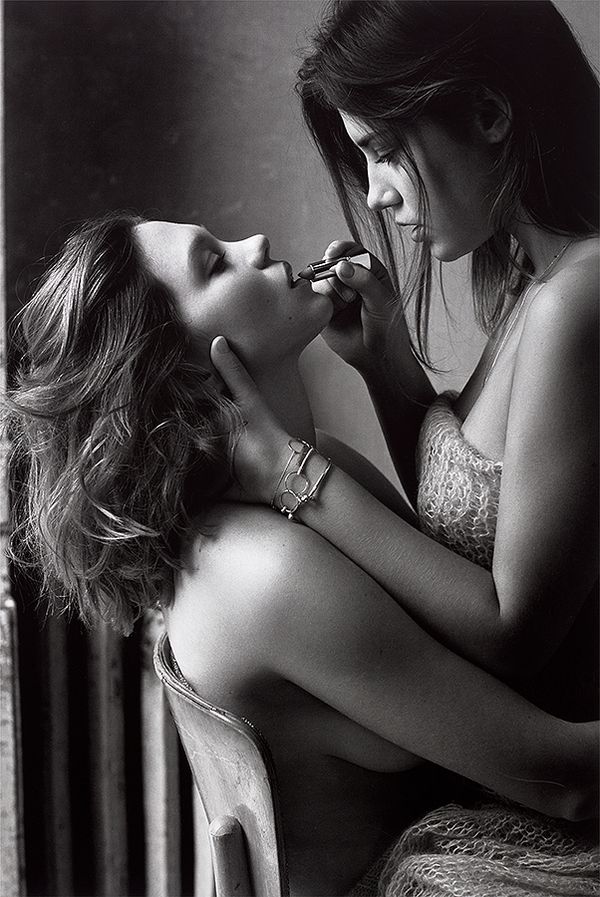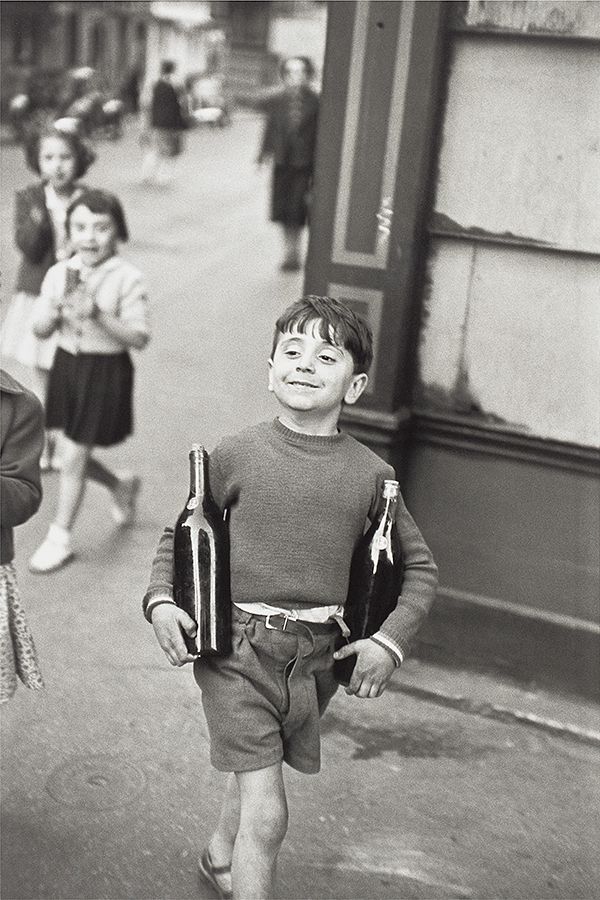Henri Cartier-Bresson, Rue Mouffetard, Paris, 1954. SPOTLIGHT: Photographs from A Private London Collection Online Auction.
—Written by Chris Cotonou
“Photography is an immediate reaction.”
Henri Cartier-Bresson’s famous motto on his métier could not find itself a better example than in his Rue Mouffetard, Paris: an image of a mischievous boy proudly carrying wine bottles in either of his arms — the object of admiration to the other children surrounding him and a vision of innocent triumph.
“Immediate reactions” is a theme that characterizes an upcoming selection of photographs from a private collection on view at Phillips London and open for online bidding from 7 July. These images, irrespective of their time, elicit as much of a response from the spectator as the person who captured the moment behind the camera, immortalized as vivid windows into another world, another person’s soul, and into everyday life.
Cartier-Bresson’s iconic photograph can be juxtaposed with another curious slice of life (also an example of innocent triumph) from the same selection: Bruce Davidson’s Wales (Boy Pushing Carriage) from 1965. It is a personal favorite of mine, and a highlight from his lauded Wales series, in which Davidson uncovers the beauty in a life that is seemingly bleak. Although the image is widely recognized, it tells a more textured story when seen in person, when the industrial background is carefully studied, and when the incline of the steep hill behind the boy speaks to us of perseverance — like Sisyphus rolling his boulder… only for it to fall back down again.

Bruce Davidson, Wales (Boy Pushing Carriage), 1965. SPOTLIGHT: Photographs from A Private London Collection Online Auction.
As with the entire selection available, Wales is both a stylish and provocative work. Along with these grounded snapshots of reality, there are also blockbuster names across fashion, music, and cinema, from Rankin, Martin Parr, and Annie Leibovitz, but all of the artists presented in this collection are famous for the mastery with which they connected with their subjects to achieve that single, perfect “immediate reaction.” Whether it is in Juergen Teller’s maximalist portrait of Gisele Bündchen, or the shadowy corners of Joy Division’s rehearsal room from Kevin Cummins, these are images that express a secret bond between the photographer and the people on the opposite side of the lens. These masters of their craft could convey their subjects in such a way that we fantasize about encroaching on that secret bond.
But you had to be there. You had to be them.

Annie Liebovitz, Liberace and Scott Thorson, Las Vegas, 1981. SPOTLIGHT: Photographs from A Private London Collection Online Auction.
For this reason, Terry O’Neill became as much of an icon as the celebrities he photographed during the 1960s — a member of a British set of photographers who shook up the world during that swinging decade, notorious for his close friendships with the era’s jetsetters, and his marriage to Faye Dunaway. His images today have become a fixture at institutions around the globe, as well as essential additions for collectors, exposing, in his own words, “a world that doesn’t exist anymore.” There are shots of Elton John, Michael Caine and Bob Hoskins, Peter Sellers with Britt Ekland, Rod Stewart, and more of his friends at rest or play, or taken exclusively on film sets, where his relationships with the stars helped in producing images that are sometimes humorous or unique. O’Neill’s work often captures his subjects candidly, or in unusual settings, but his portraits are intimate: an early photograph of pop siren Marianne Faithfull (1964) that features in this collection was so provocative that it is partly credited with launching her career — set against a seductive noir backdrop, with Faithfull teasingly styled in black lingerie, delicately brushing aside her hair, fingers propped. The result is an image that has a searing sex appeal. Faithfull’s expression gives her a level of control in the relationship between photographer and subject, and the photograph remains an empowering, chic representation of the gradually liberating 1960s woman.

Terry O'Neill, Marianne Faithfull, 1964. SPOTLIGHT: Photographs from A Private London Collection Online Auction.
Throughout the selection, there are further portraits of iconic women. Marilyn Monroe is shown in glowing shots by Bert Stern for Vogue from 1962, taking place over three daily sessions, just six weeks before she tragically died. It is another vision of an artist who reveres his subject. Stern knew that Monroe loved the Hotel Bel-Air and organized the shoot there to make her feel comfortable, recognizing the fragilities of the actress. Dressed in Christian Dior, a defining image sees a pensive Monroe sitting in front of a white background, wearing a black velour gown. The starlet’s emotions are exposed in her sideways glance, and yet she seems impossibly sexual, vulnerable, and distant.

Bert Stern, Marilyn Monroe, from The Last Sitting, 1962. SPOTLIGHT: Photographs from A Private London Collection Online Auction.
Bringing us more towards the present, one cannot help but observe how the more contemporary portraits of actresses still hold a similar feeling of sensual mystery as the women before them. Rankin’s images of Eva Green (2010/2011) are among the photographer’s favorites across his canon of work — the Bond Girl’s darkly gothic, seductive stare embodying the modern-day actress. Likewise, Swedish photographer Mikael Jansson’s images of French starlets Adele Exarchopoulos and Léa Seydoux, Léa & Adele (2013) are cool and erotic pieces that follow their success at Cannes with the Palme d’Or winning Blue is the Warmest Colour. Also in the selection is an example from Bruce Weber’s longtime relationship and creative collaboration with Kate Moss — Kate Moss, Seville, Spain (2000) — in which the young supermodel wears a traditional Andalusian Cordoba hat. Since Weber presented the series, his images of his subject have continued to resurface and become lauded as the defining portrayal of Moss at her very peak. These are photographs that represent the most defining women of their era with depth and emotion, but also with incredible doses of glamour.

Rankin, Eva Green, The Cast, 2010. SPOTLIGHT: Photographs from A Private London Collection Online Auction.

Mikael Jansson, Léa & Adèle #6, Villecresnes, 2013. SPOTLIGHT: Photographs from A Private London Collection Online Auction.
Whether it is Cartier-Bresson and Davidson’s triumphant kids, Martin Parr’s thrilling, dangerous tattooed English patriot, the Queen of England, or portraits of dazzling starlets, a sense of overcoming and triumph is felt through the eyes, the smiles, the glares, and the frank voyeurism of the most deeply thoughtful artists paying attention to the world and the people in front of them.
If the selection teaches us anything, it’s that an “instant reaction” is only attainable through a relationship — through that impenetrable bond that is shared by the artist and the subject at the right moment. What a privilege it is to be able to witness that spotlight moment, captured through these sublime works of art.

Bruce Weber, Kate Moss, Seville, 2000. SPOTLIGHT: Photographs from A Private London Collection Online Auction.
Discover More from SPOTLIGHT: Photographs from a Private London Collection Online Auction >
About the Writer:
Chris Cotonou is Deputy Editor of A Rabbit's Foot — a recently launched magazine and digital platform covering film, art, and culture. His writing has appeared in Esquire, The Rake, Evening Standard Online, GQ, Robb Report, and Mr. Porter.
Recommended:
